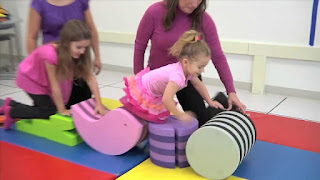Erb's palsy And Physiotherapy Treatment :
Erb's palsy also called Erb's Duchenne palsy is a paralysis of the arm(Upper Limb). This injury is caused mainly Due to injury to the upper group of the arm's main nerves, Mainly the injury of the upper trunk C5–C6 nerves root. These Nerve Root form part of the brachial plexus, Forming the ventral rami of spinal nerves C5–C8 and One thoracic nerve T1. These injuries Occurs most commonly, but not exclusively, from shoulder dystocia during a difficult birth. Depending on the nature of the damage, the paralysis can either resolve on its own over a period of months, necessary Physiotherapy Treatment or Severe Injury May require surgical Intervention.
The paralysis can be partial or complete; the damage to each nerve can range from bruising to Complete Tear. The most commonly involved Nerve root is C5 (aka Erb's point: the union of C5 - C6 roots) as this is mechanically the furthest point from the force of traction, therefore, the first/most affected Nerve Root. Erb–Duchenne palsy presents as a lower motor neuron Injury with sensibility Loss and vegetative phenomena.
The most commonly involved nerves are the suprascapular nerve, musculocutaneous nerve, and the axillary nerve.
The signs of Erb's Palsy include loss of sensation in the arm and paralysis or wekness of the deltoid, biceps, and brachialis muscles. "The position of the limb, under such conditions, is by : the arm hangs by the adducted and is rotate internally ; the forearm is in pronation and exntension position. Sholder Abduction, elbow Flexion And Supination is lost Mainly. The resulting Condition Look's Like Postion Also Called "waiter's tip Hand ".
If this injury occurs at early age May Leads to affect development (e.g. as a neonate or infant), it often leaves the patient with Delayed growth in the affected arm with everything from the shoulder through to the fingertips smaller than Compare to Normal arm. This also leaves the patient with Delayed muscular, Nervous & circulatory development. The Delayed of musculer development May leads to the arm being much weaker than a Normal one, and less articulation, with many patients unable to lift the arm above shoulder height, as well as leaving many with a Muscle contracture.
Which are the Cause of Erb's Palsy ?
 |
| Erb's Palsy From Front And Back Side |
Erb's palsy also called Erb's Duchenne palsy is a paralysis of the arm(Upper Limb). This injury is caused mainly Due to injury to the upper group of the arm's main nerves, Mainly the injury of the upper trunk C5–C6 nerves root. These Nerve Root form part of the brachial plexus, Forming the ventral rami of spinal nerves C5–C8 and One thoracic nerve T1. These injuries Occurs most commonly, but not exclusively, from shoulder dystocia during a difficult birth. Depending on the nature of the damage, the paralysis can either resolve on its own over a period of months, necessary Physiotherapy Treatment or Severe Injury May require surgical Intervention.
 |
| Nerve Root Explanation From Cervical Area |
The paralysis can be partial or complete; the damage to each nerve can range from bruising to Complete Tear. The most commonly involved Nerve root is C5 (aka Erb's point: the union of C5 - C6 roots) as this is mechanically the furthest point from the force of traction, therefore, the first/most affected Nerve Root. Erb–Duchenne palsy presents as a lower motor neuron Injury with sensibility Loss and vegetative phenomena.
 |
| Infant Nerve Root And Brachial Plexus |
The most commonly involved nerves are the suprascapular nerve, musculocutaneous nerve, and the axillary nerve.
The signs of Erb's Palsy include loss of sensation in the arm and paralysis or wekness of the deltoid, biceps, and brachialis muscles. "The position of the limb, under such conditions, is by : the arm hangs by the adducted and is rotate internally ; the forearm is in pronation and exntension position. Sholder Abduction, elbow Flexion And Supination is lost Mainly. The resulting Condition Look's Like Postion Also Called "waiter's tip Hand ".
 |
| Brachial Plexus |
If this injury occurs at early age May Leads to affect development (e.g. as a neonate or infant), it often leaves the patient with Delayed growth in the affected arm with everything from the shoulder through to the fingertips smaller than Compare to Normal arm. This also leaves the patient with Delayed muscular, Nervous & circulatory development. The Delayed of musculer development May leads to the arm being much weaker than a Normal one, and less articulation, with many patients unable to lift the arm above shoulder height, as well as leaving many with a Muscle contracture.
Which are the Cause of Erb's Palsy ?
 |
| Cause Of Erb's Palsy |
- Congenital
- Dystocia ( Difficult ChildBirth-Labor)
- Fracture At Clavicle to Neonates.
- Any age following trauma to the head and shoulder.
 |
| Waiter's Tip Hand Position |
How Diagnosis is done in Erb's Palsy ?
Examine The Patient's Arm Position Like Adducted From Sholder, Extended From Eblob Joint And Pronated Position With Weakness or Paralysis Of Deltoid, Brachialis,Biceps Most Commonly.
Further Investigation Is By EMG/NCV Reports Or By MRI Accordingly.
 |
| Prognosis Of Erb's Palsy |
Treatment :
 |
| Treatment in Erb's Palsy |
Some babies recover on Gradually With Physiotherapy Treatment however, Patient some may require specialist intervention or Surgical Procedure According To Injury.
Neonatal/pediatric neurosurgery is often required for avulsion Injury. Lesions may heal Naturally Over Time and function Gradually return With Help Of Exercise Therapy.
Physiotherapeutic care is required Mainly to restore muscle Function. Although range of motion is recovered in many children under one year in age, individuals who have not yet healed after this point will rarely gain full function in their arm and may develop Deformity.
The three most common treatments for Unrecoverable Erb's Palsy are :
1. Nerve transfers (usually from the opposite arm or limb)
2. Sub Scapularis releases and Latissimus Dorsi Tendon Transfers.
Physiotherapy Treatment :
 |
| Physiotherapy Treatment In Erb's Palsy |
Assessment Of Patient Mainly Muscle Chart Of Whole Upper Limb And Range Of Motion And RD Test are required.
Accordingly assessment Physiotherapy Treatment Plan are carried out And Monitoring Progress Report With SD Curve At Every 10 Days Helps Recovery Process Going On.
According to Muscle Chart Strengthening Exercise, Electrical Stimulation, Passive Movement Or Active Assisted Exercise Are Design.
Home Exercise Are Teached To Patient's Relative And Deformity Correction Position And Splinting Training Are Also Required.
Mainly Aeroplane Splint Commonly Used But It May Be Vary According To Condition.
 | ||
| Splinting in Erb's Palsy |
 |
| Aeroplane Splint |







